Naturism, or Freikörperkultur (FKK), meaning “free body culture” in German, has long held a unique place in the cultural landscape of Germany. It reflects a deep-rooted appreciation for freedom, nature, and the human form in its natural state. From its early stirrings in the late 19th century to its development into a widespread movement, German naturism evolved into a distinct lifestyle that has influenced global perceptions of nudity and human connection with nature.
The Origins of FKK: Nature and Freedom
The seeds of German naturism were sown in the mid-to-late 19th century, when societal changes brought about by industrialization and urbanization led to new ways of thinking about health, freedom, and the human relationship with nature. By the late 1800s, a growing number of intellectuals, health advocates, and reformers began to critique the increasingly sedentary and disconnected lives that people were leading in rapidly expanding cities. They championed a return to the natural world and, with it, a reevaluation of how humans should live in harmony with nature.
The “Lebensreform” (Life Reform) movement, which advocated for vegetarianism, natural healing, and simple living, played a significant role in the rise of naturism. Many of its adherents promoted a healthy lifestyle that included exercise, outdoor activities, and a rejection of the constraints of modern fashion. They viewed the human body as a natural and beautiful form, one that should not be hidden behind clothing. This philosophy, combined with an emphasis on physical fitness and fresh air, laid the groundwork for FKK.
By the turn of the 20th century, Germany became fertile ground for naturism. The idea of engaging with nature without the interference of clothing began to resonate with a growing number of people, who saw it as a means of achieving physical health, mental clarity, and spiritual well-being.
Early Growth: The First Naturist Movements
The first organized naturist groups emerged in Germany in the early 20th century. In 1903, Richard Ungewitter, a major figure in early German naturism, published a book titled Die Nacktheit (Nakedness), which advocated for social nudity as a means of promoting health, morality, and a closer connection to nature. Ungewitter’s ideas were considered radical at the time, but they gained traction among progressive thinkers who saw naturism as a rejection of the stifling conventions of the day.
Around the same time, the first official naturist clubs were established. The earliest known organization was the Freilichtpark (Free Light Park) founded in 1903 near Hamburg by Paul Zimmermann. This club was specifically designed for individuals to enjoy nature unclothed, and it is considered one of the first modern naturist communities in the world. Over time, other naturist clubs followed, providing spaces where like-minded people could gather, exercise, and embrace the ideals of FKK.
The early FKK movement was closely aligned with physical fitness and the body culture movement that swept across Europe. Sports, gymnastics, and outdoor activities were central to the naturist experience, and naturist resorts often included facilities for swimming, hiking, and other physical pursuits. Proponents of FKK believed that being naked in nature allowed people to attain a level of physical and mental well-being that was impossible in the urban, clothed world.
Naturism in the Weimar Republic
The period of the Weimar Republic (1919-1933) saw the flourishing of naturism in Germany, as the political and social climate became more open to new ideas about personal freedom and bodily autonomy. During this time, FKK became more widely accepted, particularly in urban centers like Berlin and Hamburg, where a thriving culture of avant-garde art, literature, and alternative lifestyles had taken root.
Several new naturist clubs and associations were founded during this period, and FKK began to attract a broader audience. By the 1920s, there were hundreds of naturist organizations throughout Germany, some of which were dedicated to specific activities such as hiking or swimming. Publicity surrounding these groups helped to bring FKK into the mainstream, although it was still viewed with some suspicion by conservative elements of society.
FKK was also influenced by the emerging field of psychoanalysis, particularly the ideas of Sigmund Freud. Freud’s theories about the relationship between the body, sexuality, and repression resonated with naturists, who saw nudity as a way to break free from the psychological constraints imposed by society. For many, the FKK movement was not just about physical health but also about emotional and psychological liberation.
The Nazi Era and Suppression
Despite the growing popularity of FKK during the Weimar years, the rise of the Nazi regime in 1933 marked a difficult period for German naturism. Initially, the Nazi government, with its emphasis on physical fitness and racial purity, tolerated some forms of nudism, particularly in the context of athleticism and physical culture. However, the regime was also deeply conservative in its views on morality, and as a result, many naturist organizations were banned or placed under strict government control.
In 1933, the Nazi government dissolved most naturist organizations, viewing them as subversive or morally corrupt. However, some clubs managed to survive by aligning themselves with the regime’s ideals of physical fitness and national pride. These organizations were forced to adopt more conservative policies, and much of the ideological diversity that had characterized the FKK movement in the 1920s was lost. The focus shifted away from personal freedom and individual expression, and naturism became more closely associated with the regime’s propaganda about racial purity and physical strength.
Despite these restrictions, FKK continued to exist, albeit in a more constrained form. Naturism was allowed to continue in private settings, and some naturist resorts were permitted to operate as long as they adhered to the regime’s strict guidelines. However, the spirit of the movement was severely compromised, and it was not until after World War II that FKK began to regain its former vitality.
Post-War Resurgence and the GDR Divide
Following the devastation of World War II, Germany was divided into two nations: the Federal Republic of Germany (West Germany) and the German Democratic Republic (East Germany). This division had a significant impact on the development of naturism, as the two Germanies took different approaches to the movement.
In East Germany, FKK became surprisingly popular, especially in coastal areas along the Baltic Sea. Despite the GDR’s authoritarian government, naturism was widely tolerated, and the state even promoted it as a wholesome and healthful activity. For many East Germans, FKK represented a form of freedom in an otherwise restrictive society, and nude beaches and resorts became common sights along the GDR’s northern coast.
West Germany, on the other hand, experienced a more conservative backlash in the immediate post-war years. Naturism was seen by some as a relic of the past, and it took several decades for FKK to regain widespread acceptance. However, by the 1960s and 1970s, naturism began to enjoy a resurgence, particularly as part of the countercultural movements of the time. The sexual revolution, along with growing interest in personal freedom and alternative lifestyles, helped to bring FKK back into the mainstream.
In both East and West Germany, naturist resorts and beaches flourished, and the movement once again became a central part of German culture. By the 1980s, FKK had fully reestablished itself as a popular and accepted practice in both countries, although it was often viewed through different political lenses. In the GDR, naturism was seen as a form of state-sanctioned leisure, while in West Germany, it was often associated with individual freedom and rebellion against social norms.
Modern FKK: Unity and Continuity
With the reunification of Germany in 1990, the divide between East and West German naturism disappeared, and FKK entered a new phase of development. Today, Germany is one of the world’s leading countries for naturism, with a wide variety of clubs, resorts, and nude beaches. FKK is seen by many Germans as a natural and normal part of life, and it is common to find people sunbathing naked in parks, swimming nude in lakes, or hiking through forests in the nude.
In contemporary Germany, naturism is no longer associated with radical political movements or countercultural ideas. Instead, it has become a mainstream practice, embraced by people of all ages and backgrounds. FKK is viewed as a way to relax, enjoy nature, and maintain a healthy lifestyle. While some traditional naturist clubs still exist, many Germans prefer to practice FKK informally, without the need for membership or organized activities.
A Tradition of Freedom and Nature
The history of naturism in Germany is a testament to the enduring human desire for freedom, health, and connection with nature. From its early roots in the Lebensreform movement to its modern-day expression in parks and beaches across the country, FKK has evolved into a unique cultural phenomenon that reflects Germany’s deep respect for the natural world and the human body.
While naturism in Germany has undergone many changes over the past century, its core values have remained consistent: the belief that the human body is beautiful and natural, and that spending time in nature without the constraints of clothing can lead to a healthier, happier life. In this way, the legacy of FKK continues to thrive in Germany and serves as an inspiration to naturists around the world.

